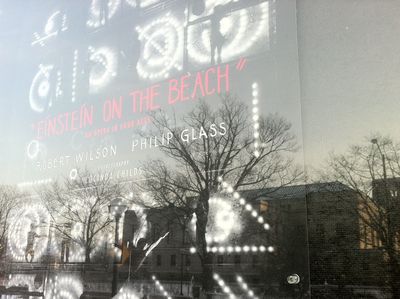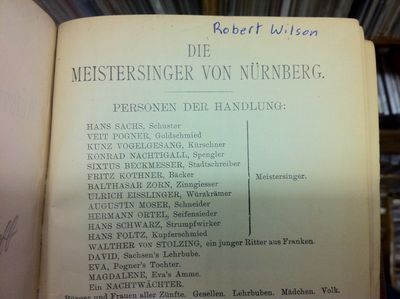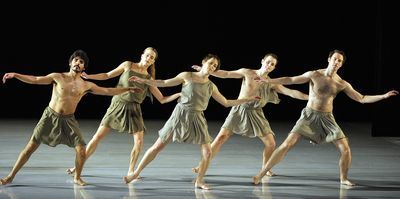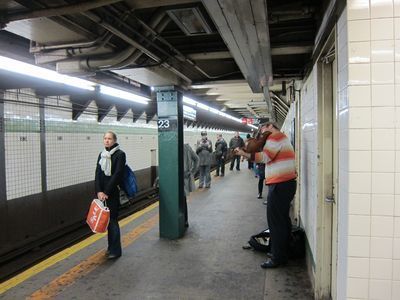Alex Ross's Blog, page 206
January 21, 2012
These are the days my friends
After a twenty-year rest, Philip Glass and Robert Wilson's Einstein on the Beach has reawakened in snowy Ann Arbor, Michigan. I've waited half my life to see the piece, and I was decidedly undisappointed: what an ecstatically dumbfounding thing this is. I'll say more in a piece on Glass's seventy-fifth-birthday festivities in The New Yorker next month.
Browsing at Encore Records beforehand — Ethan Iverson introduced me to this excellent store last year — I picked up a miniature score of Die Meistersinger and happened upon a curious coincidence:
It all goes back to Wagner.
January 2, 2012
Busoni's Piano Concerto
The Monster Concerto. The New Yorker, Jan. 9. 2012.
December 29, 2011
Apex 2011
A year-end list of memorable performances, with some preliminary thoughts on music, money, and power.
December 23, 2011
Hiatus
I'll resume blogging sometime in January, although posting will be more sporadic than before; after two years of research, I've finally made a start on the writing of my next book, Wagnerism. Happy holidays to all, and thanks for reading.
My Favorite Records: Mark Morris
Photo: Morris's Socrates, by Gene Schiavone
Last month, Björk inaugurated a My Favorite Records feature on the blog. This month's list is by the choreographer, dancer, and director Mark Morris, one of the most purely musical people alive. He writes: "Not the same list as Greatest Music of All Time, or What's on My iPod, or Listen to This Because It's Good For You. These are all thrillers that I keep returning to."
EUIS KOMARIAH The Sound of Sunda (GlobeStyle)
M. S. SUBBULAKSHMI Live at Carnegie Hall, U.S.A. (Saregama)
NELLIE LUTCHER The Best of Nellie Lutcher (Blue Note)
J. S. BACH Concertos for Two and Three Pianos; Gaby Casadesus, Robert Casadesus, Jean Casadesus, various orchestras and conductors (Sony)
MOZART Così fan tutte; Bernarda Fink, Graciela Oddone, Marcel Boone, Werner Güra, Véronique Gens, Pietro Spagnoli, René Jacobs conducting the Concerto Köln (Harmonia Mundi)
RUTH ETTING Ten Cents a Dance (ASV/Living Era)
SCHMIDT AND JONES The Fantasticks: Original Cast Album (Decca Broadway)
BOB WILLS AND HIS TEXAS COWBOYS For the Last Time (United Artists)
PROKOFIEV The Five Piano Concertos; Alexander Toradze, piano, with Valery Gergiev conducting the Mariinsky Orchestra (Philips)
HAYDN The Seven Last Words of Our Saviour on the Cross; Benita Valente, Jon Humphrey, Jan DeGaetani, Thomas Paul, Juilliard String Quartet (Sony)
IVOR CUTLER An Elpee and Two Epees (Universal UK)
LOU HARRISON Concerto for Organ with Percussion Orchestra, Concerto for Violin with Percussion Orchestra; David Craighead, organ, Eudice Shapiro, violin, with William Kraft conducting the Los Angeles Percussion Ensemble (Crystal)
December 22, 2011
Clipping
"That was one of the things about this war; it took a little fellow from a little town, gave him an air and a swagger, a life like a movie-film,— and then a death like the rebel angels."
— Willa Cather, One of Ours
The Armageddon Chorus
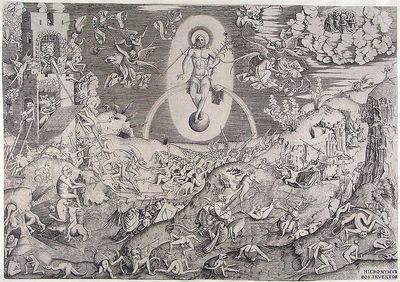
Younger classical critics at the New York Times are regularly subjected to a kind of hazing ritual, in which they are directed to attend multiple performances of Messiah around the city. I hasten to add that more than a few of these renditions are excellently played and sung, and keep many a free-lance musician solvent through the holidays. Zachary Woolfe is the latest to run the gauntlet, and is kind enough to quote my own effort, from 1993. Back then, I observed that the text of the Hallelujah Chorus is derived from the Book of Revelation, and that the context of those famous lines puts a different spin on the wholesome scene of celebration that most Messiah performances evoke:
I heard as it were the voice of a great multitude, and as the voice of many waters, and as the voice of mighty thunderings, saying, Alleluia: for the Lord God omnipotent reigneth....
And I saw heaven opened, and behold a white horse; and he that sat upon him was called Faithful and True, and in righteousness he doth judge and make war.
His eyes were as a flame of fire, and on his head were many crowns; and he had a name written, that no man knew, but he himself.
And he was clothed with a vesture dipped in blood: and his name is called The Word of God.
And the armies which were in heaven followed him upon white horses, clothed in fine linen, white and clean.
And out of his mouth goeth a sharp sword, that with it he should smite the nations: and he shall rule them with a rod of iron: and he treadeth the winepress of the fierceness and wrath of Almighty God.
And he hath on his vesture and on his thigh a name written, KING OF KINGS, AND LORD OF LORDS.
Perhaps the Messiah organist on crack was trying to recapture some of that apocalyptic atmosphere.
Bach on the F
The inaugural edition of Make Music Winter, which unfolded in New York yesterday, included Thruline, a delightful musical installation by the composer James Holt. For one hour in the early evening, musicians from the chamber orchestra The Knights were positioned at all forty-four stops along the F subway line, each one playing the prelude from Bach's G-major Cello Suite. Holt further explains the project on the MATA blog. I didn't make it all the way to Coney Island, but I caught quite a few Thruline performances in Manhattan, enjoying the peculiar sensation of riding the subway with no destination in mind. I'm not sure how many commuters fully grasped what was going on — it was sometimes difficult to hear the players from inside the car, unless you were positioned near the door — but I liked the idea of a subliminal Bachian occupation. The video above shows Guillaume Pirard at the West 4th Street stop, detouring into the Sarabande before resuming the prelude as the doors close. Below are Lev "Ljova" Zhurbin at West 23rd and an unidentified cellist at Delancey.
December 21, 2011
Researchers say...
...that Beethoven avoided high notes in his middle period.
The Carafa popes
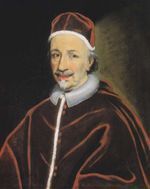 Among many curious details that I had no space to mention in my Gesualdo piece is the fact that Fabrizio Carafa — the legendarily beautiful young man whom Gesualdo murdered in 1590, on the same night that the Prince killed his no less legendarily beautiful wife — was a grandfather of a pope. I have been unable to pin down the date of Fabrizio's birth, but he was probably around thirty when he died. He married very young — his wife, Maria, was only fourteen — and amongst his other activities managed to father five children. After the unfortunate events of 1590, Maria Carafa became devoutly religious, entering the Dominican convent of Santa Maria della Sapienza. Her daughter Porzia, born in 1589, married Francesco Pignatelli, and their son Antonio ascended to the papacy in 1691, as Innocent XII (pictured). He is generally considered to have been a benevolent and reformist pope, noted for his attempts to curtail nepotism. Less cherished in memory is the principal Carafa pope, Paul IV, whose short reign (1555-59) was one of the bleakest in the history of the Vatican. Among Paul IV's first acts was the monstrous papal bull Cum nimis absurdum, which established the Jewish ghetto in Rome and forced Jews to identify themselves by wearing the color yellow. There was a great celebration in the streets when Paul IV died; rioters mockingly disfigured a statue of him by placing a yellow hat on top of it and then lopping off the head. The succeeding pope, Pius IV, pardoned the protesters and ordered the execution of two of the late pope's nephews. Pius IV's niece was, as it happens, Carlo Gesualdo's mother.
Among many curious details that I had no space to mention in my Gesualdo piece is the fact that Fabrizio Carafa — the legendarily beautiful young man whom Gesualdo murdered in 1590, on the same night that the Prince killed his no less legendarily beautiful wife — was a grandfather of a pope. I have been unable to pin down the date of Fabrizio's birth, but he was probably around thirty when he died. He married very young — his wife, Maria, was only fourteen — and amongst his other activities managed to father five children. After the unfortunate events of 1590, Maria Carafa became devoutly religious, entering the Dominican convent of Santa Maria della Sapienza. Her daughter Porzia, born in 1589, married Francesco Pignatelli, and their son Antonio ascended to the papacy in 1691, as Innocent XII (pictured). He is generally considered to have been a benevolent and reformist pope, noted for his attempts to curtail nepotism. Less cherished in memory is the principal Carafa pope, Paul IV, whose short reign (1555-59) was one of the bleakest in the history of the Vatican. Among Paul IV's first acts was the monstrous papal bull Cum nimis absurdum, which established the Jewish ghetto in Rome and forced Jews to identify themselves by wearing the color yellow. There was a great celebration in the streets when Paul IV died; rioters mockingly disfigured a statue of him by placing a yellow hat on top of it and then lopping off the head. The succeeding pope, Pius IV, pardoned the protesters and ordered the execution of two of the late pope's nephews. Pius IV's niece was, as it happens, Carlo Gesualdo's mother.
Alex Ross's Blog
- Alex Ross's profile
- 425 followers


